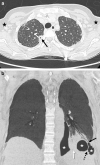Severe bilateral pleuropneumonia caused by Legionella sainthelensi: a case report
- PMID: 34535079
- PMCID: PMC8447505
- DOI: 10.1186/s12879-021-06651-1
Severe bilateral pleuropneumonia caused by Legionella sainthelensi: a case report
Abstract
Background: Legionella spp. are ubiquitous freshwater bacteria responsible for rare but potentially severe cases of Legionnaires' disease (LD). Legionella sainthelensi is a non-pneumophila Legionella species that was first isolated in 1980 from water near Mt. St-Helens (USA). Although rare cases of LD caused by L. sainthelensi have been reported, very little data is available on this pathogen.
Case presentation: We describe the first documented case of severe bilateral pleuropneumonia caused by L. sainthelensi. The patient was a 35-year-old woman with Sharp's syndrome treated with long-term hydroxychloroquine and corticosteroids who was hospitalized for an infectious illness in a university hospital in Reunion Island (France). The patient's clinical presentation was complicated at first (bilateral pneumonia, multiloculated pleural effusion, then bronchopleural fistula) but her clinical condition eventually improved with the reintroduction of macrolides (spiramycin) in intensive care unit. Etiological diagnosis was confirmed by PCR syndromic assay and culture on bronchoalveolar lavage.
Conclusions: To date, only 14 documented cases of L. sainthelensi infection have been described worldwide. This pathogen is difficult to identify because it is not or poorly detected by urinary antigen and molecular methods (like PCR syndromic assays that primarily target L. pneumophila and that have only recently been deployed in microbiology laboratories). Pneumonia caused by L. sainthelensi is likely underdiagnosed as a result. Clinicians should consider the possibility of non-pneumophila Legionella infection in patients with a compatible clinical presentation when microbiological diagnostic tools targeted L. pneumophila tested negative.
Keywords: Case report; Legionella sainthelensi; Legionnaires’ disease; PCR syndromic testing; bilateral pleuropneumonia.
© 2021. The Author(s).
Conflict of interest statement
The authors declare that they have no competing interests.
Figures

References
-
- Shah P, Barskey A, Binder A, Edens C, Lee S, Smith J, et al. Legionnaire’s disease suveillance summary report, Unites States, 2014–2015. Centers for Disease Control and Prevention; 2019. https://www.cdc.gov/legionella/health-depts/surv-reporting/2014-15-surv-....
-
- Vandewalle-Capo M, Massip C, Descours G, Charavit J, Chastang J, Billy PA, et al. Minimum inhibitory concentration (MIC) distribution among wild-type strains of Legionella pneumophila identifies a subpopulation with reduced susceptibility to macrolides owing to efflux pump genes. Int J Antimicrob Agents. 2017;50(5):684–9. doi: 10.1016/j.ijantimicag.2017.08.001. - DOI - PubMed
Publication types
MeSH terms
Supplementary concepts
LinkOut - more resources
Full Text Sources
Medical
Research Materials
Miscellaneous

